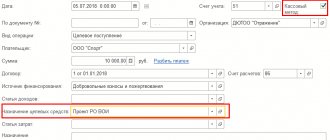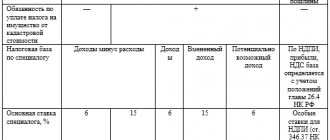Issues discussed in the material:
- What laws govern the taxation system of non-profit organizations
- What are the features of taxation of a non-profit organization
- Which financial income of a non-profit organization is taxable and which is not?
- What types of taxation are not suitable for NPOs
The area of activity of non-profit organizations (NPOs) is regulated primarily by Federal Law No. 7 “On Non-Profit Organizations” of January 12, 1996, and other federal laws established for these associations. In the budget system, the income from these institutions is insignificant, which, however, does not deprive them of the status of subjects of tax law. In this article we will take a closer look at the issue of taxation of non-profit organizations.
Legislative regulation of NPOs as a subject of tax law
Even if profit is not the main goal of non-profit structures, its presence is possible in most cases. The main thing is that its receipt pursues the stated objectives of the organization, and is not used as a cover for the purpose of tax benefits. To control the use of NPO profits for their intended purpose, there are provisions of the Federal Law of January 12, 1996 No. 7-FZ (as amended on December 31, 2014) “On Non-Profit Organizations”.
The Tax Code of the Russian Federation recognizes the obligation of non-profit organizations to pay taxes on profits, since such organizations may have them (Article 246 of the Tax Code of the Russian Federation), and to provide declarations based on accounting according to general requirements.
Average number of employees.
In accordance with paragraphs. 15 clause 3 art. 346.12 of the Tax Code of the Russian Federation does not have the right to apply the simplified tax system to organizations whose average number of employees for the tax (reporting) period, determined in the manner established by the federal executive body authorized in the field of statistics, exceeds 100 people (Letter of the Ministry of Finance of the Russian Federation dated August 13, 2019 No. 03-03 -06/1/60951).
The procedure for determining the average number of employees is established in the Instructions for filling out federal statistical observation forms No. P-1 “Information on the production and shipment of goods and , No. P-3 “Information on the financial condition of the organization”, No. P-4 “Information on the number and wages employees”, No. P-5(m) “Basic information about the organization’s activities”, approved by Rosstat Order No. 772 dated November 22, 2017 (Letter of the Ministry of Finance of the Russian Federation dated February 4, 2019 No. 03‑11‑11/6229).
The average number of employees of the organization includes:
- average number of employees;
- average number of external part-time workers;
- the average number of employees performing work under civil contracts.
Thus, the indicator “average number of employees of an organization” provides for taking into account employees in the entire organization, without distribution by type of activity. In this regard, the USN is used by the autonomous institution for the purposes of applying paragraphs. 15 clause 3 art. 346.12 of the Tax Code of the Russian Federation takes into account the average number of employees for the entire organization (Letter of the Ministry of Finance of the Russian Federation dated December 7, 2016 No. 03-11-06/2/72772).
Type of NPO and taxation procedure
Non-profit organizations are usually divided into several types according to the source of funding:
- municipal (state) - they are financed by the state budget;
- public (non-state) - exist at the expense of their own profit and public contributions;
- autonomous - finance themselves.
IMPORTANT! The procedure and amount of taxes for non-profit organizations are directly related to whether the NPO conducts business activities.
As a rule, non-profit structures are not registered as entrepreneurs, but in the course of their operation they often have to provide services or perform work for the benefit of others in order to earn funds to finance the organization, thereby generating taxable profit.
General rules for taxation of NPOs
They are due to the characteristics of these structures, namely:
- profit is not their main goal;
- they are not entrepreneurs, and they need licenses to permit certain types of activities;
- NPOs can receive income in the form of voluntary contributions, donations and other gratuitous income.
These specific properties of NPOs are the basis for the general principles by which their taxation is carried out:
- All profits received by NPOs in the course of their activities are subject to appropriate tax (Article 246 of the Tax Code of the Russian Federation).
- Certain types of profit of NPOs are not included in the base for this tax (Article 251 of the Tax Code of the Russian Federation), namely, the profit that is received free of charge to ensure statutory activities. The list of non-taxable profits of non-profit organizations is contained in the orders of the Ministry of Finance of the Russian Federation.
ANO reporting to the Ministry of Justice
Autonomous non-profit organizations are required to submit reports to the territorial branches of the Ministry of Justice, which are approved by order No. 72 dated March 29, 2010.
Submission of this reporting to the Ministry of Justice allows you to control the fact of the absence of foreigners among the members of the ANO, as well as the absence of foreign sources of funding.
Reporting forms include: (click to expand)
- form oNooo1 - information about managers;
- form oNooo2 – information on options for using ANO property;
- form oНоо1 – the amount of resources received from foreigners and international companies, stateless persons.
The first two forms are filled out by the ANO under the following conditions:
- no assets received from foreigners;
- the founders of the ANO are Russian citizens;
- revenues for the year are less than 3 million rubles.
Special rules for levying income tax
As noted above, not all profits of NPOs are eligible to be taxed. A legal reduction in the income tax base can only be applied if a number of conditions are met:
- Accounting for targeted and non-targeted income in NPOs should be kept separately; only then can targeted income be excluded from taxation on the basis of benefits for non-profit organizations. Naturally, these funds must be used exclusively for their intended purpose, which must be confirmed by a report.
- Non-targeted income must be taken into account among “other”; these are two types of income:
- sales - income from performing work, providing services (for example, selling company brochures, selling educational literature, organizing seminars, trainings, etc.);
- non-operating - those whose source does not have a direct connection with the activities of the NPO, for example, fines for non-payment of the membership fee, late fees, interest from a bank account, money for rented real estate - the property of an NPO member, etc.
Non-targeted revenues of NPOs (both groups of income), according to the Tax Code of the Russian Federation, constitute the income tax base.
REFERENCE! The income tax rate for NPOs is the same as for commercial structures: 24%, of which 6.5% will go to the federal budget, and 17.5% to the budget of the constituent entity of the Russian Federation to which the non-profit organization belongs. The last part can be reduced at the initiative of local authorities, into whose budget it is intended.
ANO reporting in the absence of activity
In the event that the activities of the autonomous non-profit organization were not carried out for any reason, there is no data on income and expenses, it is necessary to submit the following types of reports with zero indicators, which are reflected in the table below.
| Simplified accounting | · balance sheet; · report on intended use |
| Tax reporting | Declaration according to the simplified tax system |
| Reporting for employees | · 2 personal income taxes; · 6 personal income tax; · SZV-M; · SZV-experience; · ERSV; · 4 FSS |
| Statistical bodies | · Form 1-NKO; · Form No. 11 (short) |
Specifics of VAT taxation of non-profit structures
If a non-profit organization provides any services or sells goods, it cannot avoid paying value added tax if the activity does not qualify for exemption from it. The list of preferential activities without VAT is presented in Chapter. 21 Tax Code of the Russian Federation. For example, it includes the following activities:
- looking after the elderly in nursing homes;
- work in social protection centers;
- activities with children in free clubs;
- medical services of private physicians;
- sale of goods made by disabled people (or organizations where at least half of them are disabled);
- charitable cultural events, etc.
Requirements for the types of activities of NPOs for VAT exemption:
- social significance as the main goal according to Ch. 25 of the Tax Code of the Russian Federation is the main condition;
- a license to engage in this type of activity;
- the service provided must meet certain requirements (most often these are the conditions of time and place).
In case of payment, VAT is calculated according to the same principles as for commercial organizations.
Features of the association (union)
The association has the right to register both commercial and non-profit organizations. There must be at least two of them. But the participants of one association are either only commercial or only non-profit enterprises.
- The life of the organization is unlimited, provided it is not specified in the constituent documents as a separate paragraph.
- An existing association may create and register its own mark.
- In addition to the mandatory documents, others may be accepted. An example is a declaration, the content of which clearly states the tasks and goals set when creating the association.
- The Association is not authorized to engage in business. To carry it out, it is necessary to establish a business company. The second option is to participate in its work.
Other federal taxes for NPOs
In addition to the main fiscal contributions (income tax and VAT), non-profit organizations also pay other taxes and fees:
- State duty. If NPOs turn to government agencies to carry out legal actions, they pay a fee on the same basis as other individuals or legal entities. Certain NPOs and their types of activities may be exempt from state duty, namely:
- financed by the federal budget - logical, because the duty is sent there anyway;
- state and municipal repositories of cultural property (archives, museums, galleries, exhibition halls, libraries, etc.) - they may not pay state duty for the export of valuables;
- Non-profit organizations of disabled people – state fees in courts and notaries are abolished for them;
- special institutions for children with socially dangerous behavior - they are allowed not to pay a fee to collect parental debt;
- Customs duty. But this payment “does not look at individuals”, but exclusively at goods, therefore it is not exempted from it on the basis of the status of an NPO, but only if the goods are included in the corresponding list.
Necessary actions after registration
After successful registration and receipt of the appropriate certificate, it is necessary to perform a number of other actions, without which the work of the association will be blocked. They are presented in the table:
| Procedure | Explanations |
| Registration with the Territorial Body of State Statistics | The Association receives a notification regarding OKVED (national classifier of economic activity) |
| Selecting a bank and opening an account | Documents are presented, an approximate list of which is as follows:
|
| Make sure that the association has been registered with the funds (PFR and FSS), notify them about opening a bank account | Automatic registration with the funds is carried out during the registration of the association with the Ministry of Justice. This fact is reported in writing. The association is assigned a number, which must be entered into the appropriate accounting program and recorded in reports. |
The tax office, the Pension Fund of Russia, and the Social Insurance Fund must be notified within a week after the association opens a current account.
Regional taxation of NPOs
Local authorities establish the procedure for such taxation and rates, as well as benefits, including for non-profit organizations.
Property tax
Even if an organization has a benefit for this tax, it is still required to report to regulatory authorities in its tax return. The basis for accounting is the residual value of funds according to the data in the accounting records. The generally accepted rate of this tax is 2.2%, unless the regional authorities deem it necessary to reduce it, to which they have the right. Local structures also have the power to expand the list of non-profit organizations recognized as beneficiaries.
For different types of NPOs, the procedure for collecting property tax and benefits for it differs:
- Unconditional perpetual benefits for this tax on the basis of the law are provided for a number of non-profit organizations, such as:
- organizations of a religious nature and those serving them;
- scientific government agencies;
- criminal-executive departments;
- organizations that own cultural and historical monuments.
- Property tax benefits are provided to NPOs whose membership is made up of more than 50% (one type of benefit) or 80% disabled people.
- Autonomous NPOs, various foundations other than public ones, as well as non-profit partnerships do not receive property tax benefits.
Land tax
If NPOs have land plots in their ownership, perpetual use or inheritance, they are required to pay land tax. It is 1.5% of the cadastral value of the land plot. Some NPOs are completely exempt from this tax:
- societies of disabled people consisting of at least 80% (if the site is owned exclusively by them);
- penal system of the Ministry of Justice of the Russian Federation;
- religious structures.
FOR YOUR INFORMATION! Discounts on land tax for other types of non-profit organizations can be provided by local authorities.
Transport tax
If vehicles that belong to the organization on the right of ownership, management, or economic management are registered with an NPO, they are subject to transport tax on a general basis.
Step-by-step registration instructions
Associations are created in order to coordinate activities to represent and protect joint property benefits. There is a centralization of management and production functions, but the autonomy and independence of the entities included in the association is preserved. The registration process consists of several stages (steps), the essence and content of which are described in the table.
| Procedure | What does it include | Explanation |
| Step 1. Data collection and preparation | Choosing a name | Indicates the legal form and reflects what work will be carried out |
| Legal address | Locality, street, building number where the organization is located. It is indicated in the association details | |
| Definition of founders | ||
| Determining sources of financing | Funding may consist of:
| |
| Solving the issue with the authorities | General meeting (highest management body). Council – works between meetings. It is headed by a chairman. Executive Director - manages day-to-day activities | |
| Defining goals and types of functioning | Provided for in the constituent documents. Certain activities are only possible with licenses | |
| Step 2. Formation of a package of documents | Their list is described separately | |
| Step 3. Payment of state duty | The need for payment is provided for in tax legislation | The fee is 4000 rubles |
| Step 4. Submitting a package of documents to the Department of the Ministry of Justice | Documents are left against signature. Considered by the Ministry of Justice and tax authorities for 30 days | |
| Step 5. Return of the package of processed documents | The package can be obtained by presenting a receipt previously issued | |
Documents are submitted within three months from the day the decision to create the association was made.
General mode or simplified tax system
NPOs have the right to choose whether to be on the general taxation system or switch to a “simplified” one. NPOs - payers of the simplified tax system are limited to a single tax, without paying:
- income tax;
- property tax;
- VAT.
As you know, for applying the simplified tax system there is an income limit of 45 million rubles. for the last 9 months of work. For non-profit organizations, this amount does not include receipts for targeted needs (grants, donations, subsidies, contributions from founders and members, etc.).
ATTENTION! The benefit on the tax rate on employee salaries for non-profit organizations when applying the simplified tax system is no longer valid.
FAQ
Question No. 1. If an independent non-profit organization does not have a bank account, what reports must be submitted?
Reporting is submitted in a simplified form, consisting of a balance sheet and a report on the intended use of funds.
Question No. 2. Do ANOs need to submit a report on financial results?
The financial results report is not required to be submitted. It can be replaced with a report on the use of funds. It is mandatory only in the following cases:
- ANO received a decent amount of income during the reporting year;
- Profit data does not fully reflect the financial condition of the ANO.



